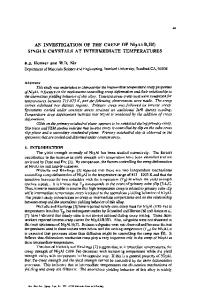Creep characteristics of single crystalline Ni 3 Al(Ta,B)
- PDF / 549,328 Bytes
- 6 Pages / 598 x 778 pts Page_size
- 44 Downloads / 501 Views
I.
INTRODUCTION
R E C E N T investigations on the creep behavior of Ni3A1 at high temperatures (T > 0.6 Tin, where Tm is the absolute melting temperature of ~ 1663 K) suggest that there is a change in the rate-controlling deformation mechanism as the testing temperature and/or applied stress is increased, tl-4] For example, single crystalline Ni3AI(Ta,B) at T = 1388 K under low values of the applied stress exhibits a stress exponent, n, of about 4.3. As the applied stress increases, the value of the stress exponent decreases to 3.2. I41 Different creep curve shapes were observed for single crystalline Ni3AI(Ta,B) depending on the value of the stress exponent. In the creep regime where a stress exponent of 4.3 is observed, the creep curve exhibits a normal primary stage, indicative of strain hardening, followed by a well-defined steady-state region. In the regime where a stress exponent of 3.2 was recorded, the creep curve initially exhibits a normal primary creep stage, after which the creep rate reaches a minimum. This is followed by a region in which the creep rate gradually increases with strain. It has been suggested that the different stress exponent regimes and creep curve shapes correspond to different rate-controlling creep mechanisms. 141 For example, a stress exponent of 4.3 is considered to be indicative of creep controlled by a dislocation climb process, while a stress exponent of 3.2 suggests that creep is controlled by a viscous dislocation glide process. In addition, it was shown that experimentally observed transition stress values between climb and viscous glide are in good agreement with values predicted from theory, assuming that the major force retarding viscous dislocation glide in Ni3AI(Ta,B) is the antiphase boundary interaction, t4] If indeed there is a change in the rate-controlling creep mechanism in Ni3A1 as the testing temperature and/or applied stress is increased, then additional evidence for this change may be
J. WOLFENSTINE, Assistant Professor, and J.C. EARTHMAN, Associate Professor, are with the Materials Section, Department of Mechanical and Aerospace Engineering, University of CaliforniaIrvine, Irvine, CA 92717-3975. H.K. KIM, Researcher, is with the Korea Academy of Industrial Technology, Guro-Gu, Seoul, Korea. Manuscript submitted October 18, 1993. METALLURGICAL AND MATERIALS TRANSACTIONS A
manifested by a difference in other creep characteristics such as the nature of the transient after a stress reduction and the activation energy for creep. The purpose of this article is to report on the nature of the creep transient after a stress reduction and the activation energy for creep in the different stress exponent regimes for single crystalline Ni3AI(Ta,B). It is shown that these additional results are consistent with the previous suggestion that the n = 4.3 regime is controlled by a dislocation climb process, whereas the n = 3.2 creep regime is governed by a dislocation glide process.
II.
EXPERIMENTAL
The single crystals of Ni3A1 used in the present investigation were pre
Data Loading...











